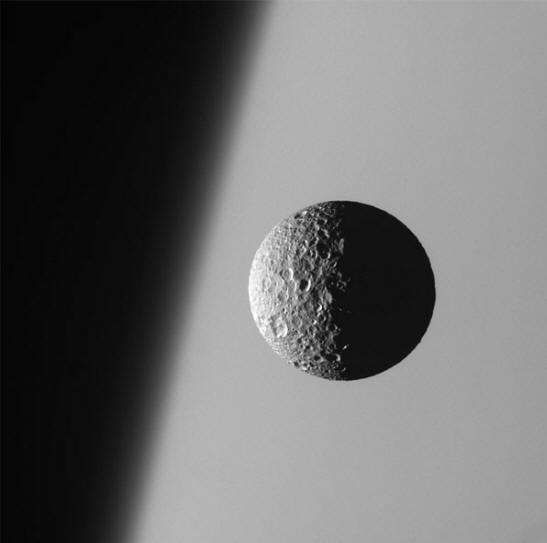|

Mimas is sharply outlined against
the giant planet Saturn. Credit:
NASA/JPL/Space Science Institute
Casualty of War
Apr 23, 2010
Saturn's moons are enigmatic,
with features that are difficult to
explain using conventional theories.
Mimas Is a tiny world, only 397
kilometers in diameter. It compares
in size to another of its sisters,
Enceladus, and to one of Neptune's
moons, Proteus. Mimas looks like the
“Death Star” space station seen in a
popular movie. The
giant crater that
dominates one of its hemispheres is
about one-eighth the diameter of the
entire moon. A crater of similar
scale would cover almost half of
Earth's Pacific basin. Why such an
enormous shock did not disrupt the
moon's material structure is a
mystery that continues to baffle
planetary scientists.
Herschel crater, named for Sir
William Herschel who discovered
Mimas in 1789, is 130
kilometers wide with a towering
central peak. Such craters are
theorized to form from asteroid
impacts. However, there is little
debris within the crater and not
many boulders or other fragments
surround it.
Researchers think that one reason
for the lack of debris is that Mimas
has little gravitational attraction,
so the blast remnants did not remain
nearby. It sounds like a plausible
explanation, except that the craters
on large planets like Earth and
Mars—some many hundreds of
kilometers wide—also demonstrate
little eruptive fallback, their
floors and sidewalls are swept
clean, though some glassified
breccia is often incorporated into
them.
The greatest puzzle of all is the
hexagonal shape of
Herschel crater. How can
an asteroid explosion cause a
hexagonal crater? No high velocity
gun experiments have demonstrated a
polygonal crater after an explosive
event. Impact events do not result
in such formations. Instead, they
are chaotic and leave behind
circular depressions with conical
bottoms.
Another
recent discovery on Mimas
is the peculiar temperature
distribution. Mimas is an extremely
cold place. Infrared measurements of
its surface by the Cassini
spacecraft reveal it to range from
-146 Celsius to -160 Celsius. It is
the strange pattern of cold that is
confusing NASA mission team members.
It was expected that Mimas would
be the warmest in the area where the
Sun's energy shines straight down.
However, the
infrared map generated by
Cassini indicates that the warmest
temperature is along the western
limb.
Other
false-color images seem
to suggest that the temperature
differences correspond to surface
composition, but no one is sure why.
It could be that the ice grains vary
in size, causing them to change the
way they reflect light.
In
previous Picture of the
Day articles, we have attempted to
provide evidence for plasma
discharges on Saturn's moons.
Lightning bolts, diffuse glow-mode
clouds of energetic particles, and
rotating Birkeland currents have
been suggested as causative agents
for the bizarre conditions found
there.
It could be that Mimas has
collected a coating of some
compounds that were eroded from the
other moons in the Saturnian system,
especially Phoebe. It was argued in
previous Picture of the Day articles
that the splotches of dark red and
sooty black coloring the faces of
Rhea, Tethys, Iapetus, and Mimas are
made of ultra fine dust electrically
etched from Phoebe.
Mimas might have once been caught
in the grip of an interplanetary
particle beam that excavated
Herschel crater and the other
geological features incised on its
face. Due to the plasma
instabilities in the discharge, a
hexagon was cut deeply into its
crust. When the electrical energy
was withdrawn, Herschel crater
remained, a “fossilized” geometric
shape permanently burned in.
The electric currents that cut
the craters and rilles on Mimas most
likely left evidence of their
passages in other ways. The
anomalous temperature measurement
that cannot be attributed to the
Sun's influence is probably one sign
of those past catastrophes. It may
be that the unusual V-shaped pattern
in the false color images from
Cassini is a warmer layer of dust
and ice that was excavated from
Herschel crater and ionically
deposited "downwind" by a
high-energy plasma discharge in the
recent past.
Stephen Smith
|







